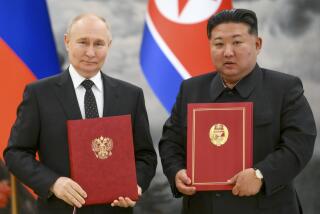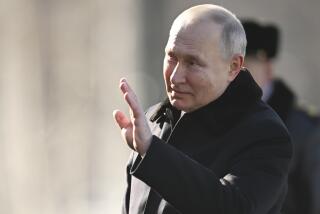Soviets to Cut Forces in Disputed Kurils : Diplomacy: Aiming for better Japanese ties, the Kremlin tells Tokyo’s visiting foreign minister of its military move.
- Share via
MOSCOW — The Soviet Union announced Monday that it is cutting its military forces by almost a third on the four disputed Kuril Islands in a move to help resolve the islands’ future, conclude a peace treaty with Japan and clear the way for broader economic cooperation.
At the opening of three days of talks here, Soviet Foreign Minister Boris D. Pankin told Japanese Foreign Minister Taro Nakayama that Moscow wants to build the “trust and confidence” necessary for resolution of the islands’ status and other issues that continue to bedevil the two nations’ relations.
Vitaly I. Churkin, spokesman for the Soviet Foreign Ministry, quoted Pankin as telling Nakayama that this reduction, 30% of the 7,000 to 8,000 troops now stationed on the islands, a few miles off northern Japan, was intended as an initial move to be followed by further measures to reduce the Soviet military presence there.
Although the Soviet action was a unilateral step that had been promised six months ago by President Mikhail S. Gorbachev during a visit to Japan, it nonetheless signaled a new effort to resolve a dispute--the future of the Kurils--that has been as costly in economic terms as it has been embarrassing politically.
The two foreign ministers agreed on new regulations that will permit Japanese to visit the Kurils, which Tokyo refers to as the “Northern Territories,” without Soviet visas and allow Soviet residents of the islands to visit Japan without visas. Pankin also proposed the creation of a “free-enterprise zone” on the islands with special treatment for Japanese businessmen and companies.
These and other Soviet proposals appeared aimed at effectively integrating the islands into the Japanese economy while easing the continuing political confrontation over the issue.
“The main thing is not to determine the final goal right now,” Pankin said, “but to follow the way of intensive development of bilateral contacts on this issue,” urging Japan “not to draw a rigid line.”
“We should bring our relations to such a level of closeness that, in principle, it would not even be very important from a legal point of view or from the point of public opinion in both countries who actually had jurisdiction over those islands,” Pankin said. “We should act in such a way that the south Kuril Islands become the place where Soviet and Japanese political, economic, humanitarian, cultural and other worlds are brought closer or even merged.”
Through the years, the Soviet Union has argued that it has a historical right to the islands, as well as a security need for them because they control naval access to the Okhotsk Sea.
But Pankin told the influential Japanese newspaper Asahi Shimbun in an interview published Monday that Moscow is reviewing the whole issue and would apply its “new political thinking” in an effort to break the deadlock. “This policy calls for a realistic view of things, a comprehensive analysis of the existing problems, proper regard for the interests of all sides as well as for social and political factors,” he said.
Japan has refused to sign a peace treaty with the Soviet Union, formally ending World War II hostilities, without the return of the islands. The four--Etorofu, Kunashiri, Shikotan and the Habomai group--were seized in the war’s final days and their residents were later deported to Japan.
Tokyo has also refused to separate political and economic issues so that the failure to resolve the territorial dispute has meant that Moscow has been unable to get much Japanese investment.
But last week, Japan granted the Soviet Union $2.5 billion in government credits and humanitarian aid; on Friday, Soviet and Japanese businessmen signed a $1.4 billion agreement for a series of projects to develop the timber resources of Siberia and the Soviet Far East over the next five years.
Pankin appealed to political leaders in both countries to avoid extreme statements. In Japan, the “Northern Territories” have long been a rallying point for the right, and the question has grown increasingly sensitive in the Soviet Union with the possibility of the islands’ return.
The islands’ current residents, numbering about 25,000, have established a special “headquarters for the defense of the Kurils” and demonstrated against any attempt to “sell” the islands to Japan for economic assistance or investment.
Valentin Fyodorov, appointed governor of the region last week by Russian Federation President Boris N. Yeltsin, invited Nakayama to stop there for “a frank exchange of opinions.” Fyodorov, who has taken a tough, nationalist stand, has said he will fight any effort to return the islands.
Yeltsin himself has proposed a five-stage plan for resolving the dispute and won backing for it from Gorbachev. While the plan spells out measures for demilitarizing the islands and opening their rich fishing waters to Japanese, it concludes in a vaguely worded call for a future generation to decide the question of sovereignty.
Before the Soviet occupation of the islands, they were inhabited by about 16,000 Japanese. Most of the current population is Russian, nearly a third of them soldiers, and fears are high that they will be forced to move.
More to Read
Sign up for Essential California
The most important California stories and recommendations in your inbox every morning.
You may occasionally receive promotional content from the Los Angeles Times.












